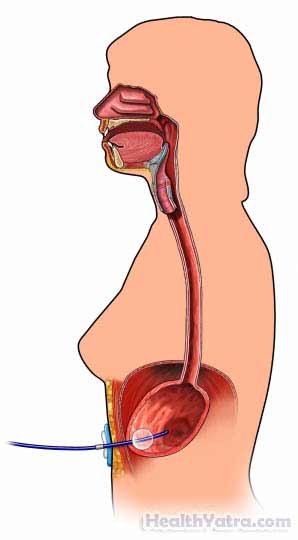Gastrostomy Surgery Cost in India
Definition
This is surgery to place a tube through the abdomen and into the stomach. Gastrostomy can be done as:
- Endoscopic procedure: a more common and less invasive procedure calledpercutaneous endoscopic gastrostomy (PEG)
- Open procedure: a long incision is made in the abdomen
Reasons for Procedure
A gastrostomy tube provides an alternative feeding site. It may be needed to:
- Feed a person who has a hard time sucking or swallowing
- Drain the stomach of acid and fluids that have built up

Possible Complications
If you are planning to have gastrostomy, your doctor will review a list of possible complications, which may include:
- Infection
- Bleeding
- Aspiration—accidental sucking into the airways of fluid, food, or any foreign material
- Damage to other organs
- Anesthesia-related problems
- Skin irritation around the tube
- Dislodging or malfunction of the tube
- Diarrhea
Factors that may increase the risk of complications include:
- Obesity or diabetes
- Smoking, alcohol abuse, or drug use
- Use of certain prescription medicines
- Prior abdominal surgeries
- Advanced age
Be sure to discuss these risks with your doctor before the surgery.
What to Expect
Prior to Procedure
Your doctor will likely do the following:
- Medical history
- Review of medicines
- Physical exam
- Assessment of swallowing ability
- Blood and urine tests
- X-rays of the abdomen
- Endoscopic examination of stomach—An endoscope is a long tube with a camera at the end that can be put down the throat into the stomach.
Leading up to your procedure:
- Talk to your doctor about your medicines. You may be asked to stop taking some medicines up to one week before the procedure, like:
- Aspirin or other anti-inflammatory drugs
- Blood thinners, such as clopidogrel (Plavix) or warfarin (Coumadin)
- Eat a light meal the night before the surgery. Do not eat or drink anything after midnight.
- Arrange for a ride to and from the hospital.
Anesthesia
General anesthesia will be used. It will block any pain and keep you asleep through the surgery.
Description of the Procedure
If you are unable to undergo PEG, the doctor will do this open procedure. In some cases, gastrostomy may be done at the same time as another stomach surgery. The doctor will make an incision through the skin, abdominal wall, and into the stomach. A tube will then be placed through the skin and into the stomach. This tube will be stitched in place. The doctor will then close the incision.
Immediately After Procedure
The doctor will make sure that the tube is placed correctly. You will be moved to the recovery room and monitored closely.
How Long Will It Take?
1 hour or longer
How Much Will It Hurt?
You will have pain after the surgery. Ask your doctor about medicine to help with the pain.
Average Hospital Stay
This procedure is done in a hospital setting. The usual length of stay is several days. Your doctor may choose to keep you longer if complications arise.
Post-procedure Care
- Depending on your condition, you may need to get nutrition through IV fluids for the first day or two after the tube placement or until your intestine is working normally. You will then be started on clear liquids. You will gradually move to thicker liquids.
- Keep the tube insertion site clean and dry.
- Wash your hands before touching the area.
- Ask your doctor about when it is safe to shower, bathe, or soak in water.
- If antibiotics are ordered, take all of the pills. Do not stop, even if you feel healthy.
- Learn how to administer tube feedings. Also, learn how to flush out your tube. This will decrease the risk of blockages.
- Learn what to do if you have a serious complication (eg, dislodged tube or aspiration).
- Be sure to follow your doctor’s instructions.
Call Your Doctor
After you leave the hospital, contact your doctor if any of the following occurs:
- Signs of infection, including fever and chills
- Redness, swelling, increasing pain, excessive bleeding, or discharge from the incision site around the tube
- Problems with the tube, including if it becomes dislodged, clogged, or malfunctions (Dislodging is most common during the first two weeks that the tube is in place.)
- Leaking of feedings around the site of the tube
- Cough, shortness of breath, chest pain
- Nausea, vomiting, constipation, or abdominal swelling
- Inability to pass gas or have a bowel movement
- Severe abdominal pain
In case of an emergency, call for medical help right away.
